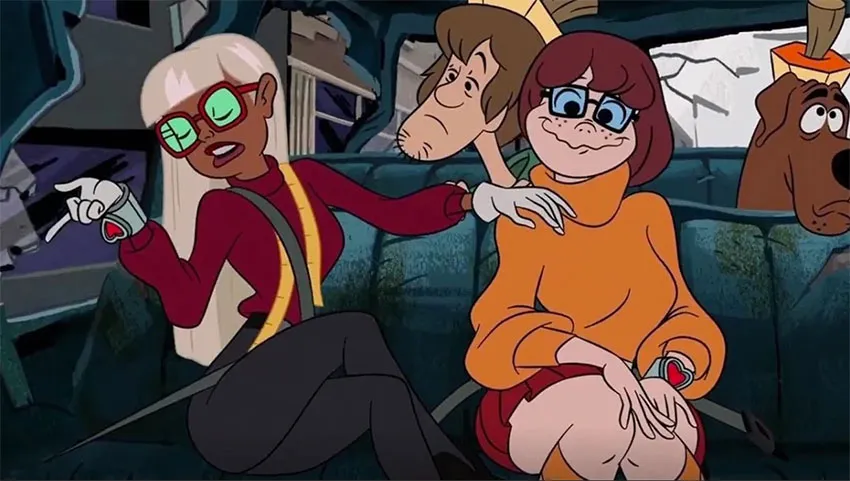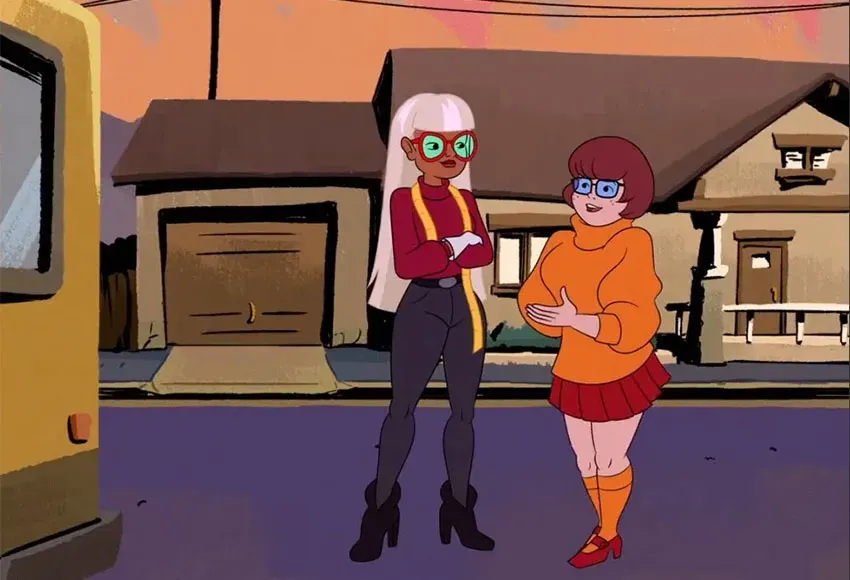Velma Dinkley, the beloved bespectacled brainiac of the Mystery Inc. gang is officially a Lesbian. The latest Scooby-Doo movie, Trick or Treat Scooby-Doo!, confirmed the character's sexuality with a subplot detailing her crush on the new character Coco Diablo. While writers have been trying for years to nail down the sexuality of the often Queer-coded character, this new film, along with the upcoming Velma series written by Mindy Kaling, is the first to overtly do so.
Long-standing speculation finally confirmed
Many fans have interpreted Velma to be a Lesbian for decades, and to some, the latest development in the Scooby Doo cinematic universe is barely news at all. However, Trick or Treat Scooby-Doo! is the first time the character has been shown explicitly as Lesbian.
The moment Velma lays eyes on Coco Diablo, romantic music swells, the frame zooms in on the fashionable new character, and a diagram points out all the reasons Velma likes her, including her glasses, turtleneck, and love of animals. Velma's glasses fog up, and she lets out an exasperated "jinkies."
As if the classic cartoon crush scene was not enough to convince fans that Velma is down bad for a woman, she later admits her feelings to Daphne, saying, "I'm crushing big time, Daphne! What do I do? What do I say?"
As mentioned, many others have tried to depict the character as Queer on-screen.
The television series Mystery Incorporated, which aired on the Cartoon Network from 2010 to 2013, hinted at Velma's sexuality but never overtly confirmed her attraction to women. While she developed a close relationship in the second season with another female character, Marcie, it was never determined that the two were an item. In this interpretation of Scooby Doo, the writers also decided to put Velma and Shaggy in a romantic relationship, distancing the idea that the character might be a Lesbian.
In 2020, Tony Cervone, one of the series' developers, posted a picture of Velma in front of the Pride flag on Instagram. He confirmed that he had always intended for her to be a Lesbian but was forced to remain ambiguous due to regulations regarding children's media.
"I've said this before, but Velma in 'Mystery Incorporated' is not bi. She's gay," Cervone said. He continued to justify the Velma and Shaggy plotline, though, writing, "We always planned on Velma acting a little off and out of character when she was dating Shaggy, because that relationship was wrong for her, and she had unspoken difficulty with the why. There are hints about the why in that episode with the mermaid, and if you follow the entire Marcie arc, it seems as clear as we could make it 10 years ago. I don't think Marcie and Velma had time to act on their feelings during the main timeline, but post reset, they are a couple. You can not like it, but this was our intention."
Despite the intentions of some of the showrunners, the only relationships Velma had in the series were with men, leaving any Queer Velma shippers to rely solely on interpretation.
She would have come out if it weren't for meddling parents!
Mystery Incorporated wasn't the first time creators tried to make Velma Gay. In the 2002 live-action adaptation Scooby Doo, writers again tried to make the character Queer. Initial scripts for the movie had a much more mature audience in mind, and the film even earned an R rating from the Motion Picture Association of America upon its first screening.
Following harsh responses from critics and parents, the creators of the movie trimmed down some of the more "offensive" material, until the film fit nicely under a PG-13 rating. Once again, parents complained about some of the content of the film, and a final cut was made, this time getting rid of language, cleavage, sexual situations – and even a kiss between Velma and Daphne!
James Gunn, who wrote the screenplay for both Scooby-Doo and the sequel Scooby-Doo: Monsters Unleashed, confirmed that in his original adaptation of the movie, Velma was Gay. "In 2001, Velma was explicitly gay in my initial script. But the studio just kept watering it down and watering it down, becoming ambiguous (the version shot), then nothing (the released version) and, finally, having a boyfriend (the sequel)."
Sarah Michelle Geller, who played Daphne in both films, also confirmed the kiss, saying in an interview, "It wasn't just, like, for fun. Initially, in the soul-swapping scene, Velma and Daphne couldn't seem to get their souls back together in the woods. And so the way they found was to kiss, and the souls went back into proper alignment."

Jinkies! What is Queer-coding?
Velma is not the first character LGBTQ+ fans have felt drawn to, and there's a reason for this. Often, when writers hoped to create a Queer character but were censored by parents and studios, like Gunn in 2002, they had to rely on unspoken hints that their characters were Gay. Only in recent years have cartoons been able to explicitly show LGBTQ+ partnership and affection on-screen.
Often, cartoons used Queer-coding to subtly mock and villainize LGBTQ+ people on-screen. One of the biggest culprits of this is Disney, which, throughout the last several decades, has depicted villains as flamboyant and gender-nonconforming. Characters like Jafar, Scar, and Hades were drawn with a dark emphasis on their eyes, to mirror makeup, and spoke with "Gay male speech," a dialect known for a higher pitch, dramatic enunciation, and sometimes lisps.
Queer-coding does not always come from writers. Human nature seeks out reflections of ourselves. This is one of the reasons compelling and relatable storytelling is so vital. For members of the LGBTQ+ community who never saw themselves represented in the media, Queer-coding became a way to relate to characters on a deeper level. Many Queer people therefore claimed iconic characters, like Velma, who they related to as members of the community.
Many of the same fans who watched The Lion King and saw Timon and Pumbaa as Gay dads raising their adopted son, or saw Frozen and claimed Elsa to be the queen of ice and Asexuals, also interpreted the bookish and nerdy Velma as a Lesbian. And to be fair, Velma did fit the aesthetic.
In older cartoons, none of the Scooby Doo gang is shown to be romantically involved with each other, as romance was inappropriate for a children's cartoon in the 1960s. Fred and Daphne's relationship developed later on, but Velma remained unattached. Her intelligence, independence, and rejection of femininity in comparison to the highly feminized Daphne made her the perfect candidate for Lesbians to claim. That, and she was played by Hayley Kiyoko in Scooby-Doo's The Mystery Begins.
Interpreted or explicit representation?
Many modern cartoons have tried to lay claim as arbitrators of LGBTQ+ progress with their depictions of same-sex relationships on-screen, and while certainly older cartoons like Scooby Doo! Mystery Incorporated helped lay the groundwork for modern representation, subtle implications of a character's queerness do not have the same effect.
Explicit representation is not only vital for LGBTQ+ viewers to see themselves in the media they consume, but it is also important for heterosexual audiences. A 2017 study out of Yale University found that people can empathize with those they view as protagonists in media. When straight viewers see LGBT+ people depicted on television, they are more likely to treat them with kindness in real life.
Furthermore, explicit representation is especially important for sapphic depictions of Queer identity. Whereas same-sex male relationships can be inferred by emotional intimacy and actions like hugging and hand-holding, these same behaviors can often be viewed as platonic among women. Because platonic intimacy is much more common among women in Western cultures, those in same-sex relationships are often delegitimized or sexualized by the heterosexual and male gaze.
In 2014, Nickelodeon's Legend of Korra wrapped up its final season. Critics and LGBTQ+ advocates hailed the series as a groundbreaking success for depicting the main character, Korra, as Bisexual. However, the series only ever implied a romantic relationship between Korra and her female "love interest," with a brief, two-second clip of the two holding hands in the last scene of the last episode.
Despite the show censoring Queer romance and affection, Korra was shown kissing male love interests on-screen multiple times. Like Velma in earlier adaptations of Scooby Doo, this was effective in possibly paving a way for better things to come but also contributed to the idea that Queer romance is more explicit and should be censored in ways that heterosexual romance is not subject to.
In 2019, the Netflix series She-Ra and the Princesses of Power opened the doors for explicit representation in children's media. Writer and showrunner N.D. Stevenson set out not just to imply a side character was Queer but to create a haven for LGBTQ+ fans to see themselves celebrated on-screen. He fought to convince Netflix executives to allow a Queer romantic arc for his two female leads. And in 2020, he made it happen, with a historic on-screen kiss between them.
Fellow animators have followed in Stevenson's footsteps. Recently, Disney's The Owl House aired an episode with an on-screen kiss between confirmed girlfriends Luz and Amity. A 2020 Adventure Time special not only showed on-screen affection between Princess Bubblegum and Marceline the Vampire Queen but depicted the two living together.
Velma can officially be out and proud in 2022 thanks to the brave Queer writers and animators who put their jobs on the line to fight for explicit representation in media. While some may have always seen Velma as a Queer-coded character, the recent confirmation of her identity speaks volumes to Queer and sapphic viewers who are finally able to see themselves in Mystery Inc.


